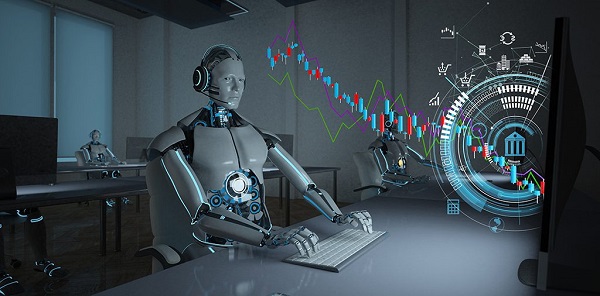Algorithmic Trading Bots

Algorithmic trading bots, at the intersection of finance and technology, are making a remarkable impact on the financial markets globally.
They represent a significant step forward in automated trading, which began as early as the late 1980s with simple computational models and has since evolved into sophisticated systems that incorporate elements of artificial intelligence (AI) and machine learning.
As we continue to witness an unprecedented surge in digital technology, these bots are becoming increasingly critical in shaping the future of financial markets.
You can start crypto automated trading with 3Commas.
Understanding Algorithmic Trading
At its core, algorithmic trading, also known as algo-trading or black-box trading, uses complex computer algorithms to make trading decisions, execute orders, and manage those orders after submission.
This method of trading is primarily rule-based, operating on pre-determined strategies which are rigorously backtested on historical data.
The algorithms consider various factors, including price, timing, and volume, and can react to market changes in real-time, ensuring the swift execution of trades at the most optimal moment.
The world of algorithmic trading is broad, encompassing several sub-types of trading algorithms. Among these, High-Frequency Trading (HFT), Statistical Arbitrage, and Mean Reversion are the most notable.
HFT utilizes high-speed computers to execute millions of orders within nanoseconds, exploiting minute price discrepancies. Statistical Arbitrage involves complex mathematical modeling to identify and capitalize on market inefficiencies.
Mean Reversion, on the other hand, operates on the statistical assumption that prices, over time, tend to revert to their mean or average levels.
Advantages of Algorithmic Trading Bots
The potential advantages that algorithmic trading bots bring to the table are manifold. The most apparent benefit is the unparalleled speed and efficiency at which transactions can be executed. Human traders simply cannot match the speed.
Another significant advantage is the elimination of human emotions from trading. Emotional responses can often lead to impulsive decisions or an inability to stick to a trading plan, which can be detrimental to trading outcomes.
By following strict, pre-determined rules, algorithmic trading bots reduce the likelihood of such trading errors.
Moreover, these bots enable the backtesting of trading strategies using historical data. This allows traders to fine-tune their strategies based on past performance and expected future behavior, thereby increasing the likelihood of a strategy’s success.
Components of Algorithmic Trading Bots
A standard algorithmic trading bot is a complex system comprising several critical components. At its heart is the trading algorithm, which defines the strategy and dictates when to buy or sell assets based on a set of conditions.
The data feed handler receives and processes live data from financial markets, ensuring the bot has access to real-time information to inform its trades. Risk management tools are an integral part of any bot, ensuring it operates within defined trading limits and mitigates potential losses.
The order routing/execution component sends the prepared orders to the market for execution.
Designing and Developing Trading Bots
Building an effective trading bot requires a high level of technical proficiency in robust programming languages and software. Beyond coding, developers also need a strong grasp of financial markets and trading principles.
Advanced knowledge of data analysis and machine learning is crucial to enhancing the bot’s performance and predictive capabilities.
Backtesting and forward testing play pivotal roles in verifying the bot’s reliability and performance before it is deployed in the live market.
Backtesting involves running the bot against historical market data to assess its performance, while forward testing (or paper trading) involves running the bot in a simulated market environment to see how it performs under current market conditions.
Risk Factors and Mitigation
Algorithmic trading bots, while offering numerous advantages, also come with their share of risks. Over-optimization is a common pitfall, which refers to excessive curve fitting of data that can lead to misleading results.
System failures due to glitches in the code, hardware issues, or even internet connectivity can result in significant losses. The risk of market manipulation also exists, where large volumes of trades can potentially influence market prices.
It’s therefore essential to have stringent risk management measures in place when using trading bots. This could include setting stop-loss and take-profit levels, maintaining diversified portfolios, setting maximum daily loss limits, and continually monitoring and adjusting the bot’s operations.
It’s also crucial to have disaster recovery measures in place to handle potential system failures.
Regulations Governing Algorithmic Trading
With the growing popularity of algorithmic trading, regulatory bodies worldwide have implemented rules and regulations to monitor and control its use. These regulations aim to ensure market fairness and transparency, prevent market manipulation, and protect individual traders.
They require firms to disclose their algorithmic trading methods and strategies, have risk controls in place, and demonstrate that they’ve conducted adequate testing of their algorithms and systems.
The Future of Algorithmic Trading Bots
The future of algorithmic trading bots is fascinating, with AI at the helm. By integrating elements of machine learning and deep learning, these bots are becoming increasingly capable of making predictions, understanding complex market patterns, and adapting to market changes in real-time.
This opens up new opportunities for traders and can revolutionize the way trading is conducted.
The utilization of trading bots is likely to proliferate across various market sectors. While they’re currently most commonly used in the equities and forex markets, there is significant potential for growth in other sectors.
Conclusion
In conclusion, algorithmic trading bots, backed by powerful AI technologies, are redefining the financial trading landscape. These bots have the potential to offer a plethora of advantages from rapid trade execution to emotionless trading, making them indispensable tools in modern finance.
As we navigate through this digital age, understanding and leveraging these bots could be a game-changer for traders, financial institutions, and all participants in the financial markets.
A comprehensive risk management approach, adherence to regulatory requirements, and continuous learning and adaptation will be key to successfully harnessing the potential of these revolutionary tools.




